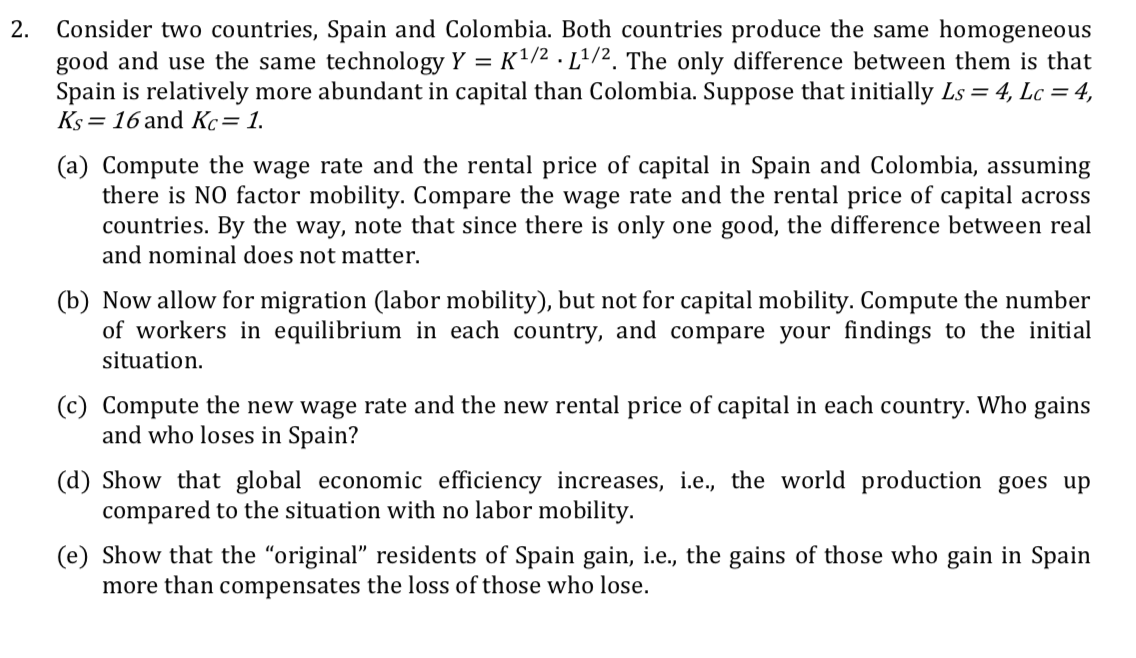Consider two countries, Spain and Colombia. Both countries produce the same homogeneous good and use the same technology Y = K1/2 . Lª/2. The only difference between them is that Spain is relatively more abundant in capital than Colombia. Suppose that initially Ls = 4, Lc = 4, Ks = 16 and Kc= 1. 2. (a) Compute the wage rate and the rental price of capital in Spain and Colombia, assuming there is NO factor mobility. Compare the wage rate and the rental price of capital across countries. By the way, note that since there is only one good, the difference between real and nominal does not matter. (b) Now allow for migration (labor mobility), but not for capital mobility. Compute the number of workers in equilibrium in each country, and compare your findings to the initial situation. (c) Compute the new wage rate and the new rental price of capital in each country. Who gains and who loses in Spain? (d) Show that global economic efficiency increases, i.e., the world production goes up compared to the situation with no labor mobility. (e) Show that the "original" residents of Spain gain, i.e., the gains of those who gain in Spain more than compensates the loss of those who lose.
Consider two countries, Spain and Colombia. Both countries produce the same homogeneous good and use the same technology Y = K1/2 . Lª/2. The only difference between them is that Spain is relatively more abundant in capital than Colombia. Suppose that initially Ls = 4, Lc = 4, Ks = 16 and Kc= 1. 2. (a) Compute the wage rate and the rental price of capital in Spain and Colombia, assuming there is NO factor mobility. Compare the wage rate and the rental price of capital across countries. By the way, note that since there is only one good, the difference between real and nominal does not matter. (b) Now allow for migration (labor mobility), but not for capital mobility. Compute the number of workers in equilibrium in each country, and compare your findings to the initial situation. (c) Compute the new wage rate and the new rental price of capital in each country. Who gains and who loses in Spain? (d) Show that global economic efficiency increases, i.e., the world production goes up compared to the situation with no labor mobility. (e) Show that the "original" residents of Spain gain, i.e., the gains of those who gain in Spain more than compensates the loss of those who lose.
Economics: Private and Public Choice (MindTap Course List)
16th Edition
ISBN:9781305506725
Author:James D. Gwartney, Richard L. Stroup, Russell S. Sobel, David A. Macpherson
Publisher:James D. Gwartney, Richard L. Stroup, Russell S. Sobel, David A. Macpherson
Chapter21: Costs And The Supply Of Goods
Section: Chapter Questions
Problem 12CQ
Related questions
Question

Transcribed Image Text:Consider two countries, Spain and Colombia. Both countries produce the same homogeneous
good and use the same technology Y = K1/2 . Lª/2. The only difference between them is that
Spain is relatively more abundant in capital than Colombia. Suppose that initially Ls = 4, Lc = 4,
Ks = 16 and Kc= 1.
2.
(a) Compute the wage rate and the rental price of capital in Spain and Colombia, assuming
there is NO factor mobility. Compare the wage rate and the rental price of capital across
countries. By the way, note that since there is only one good, the difference between real
and nominal does not matter.
(b) Now allow for migration (labor mobility), but not for capital mobility. Compute the number
of workers in equilibrium in each country, and compare your findings to the initial
situation.
(c) Compute the new wage rate and the new rental price of capital in each country. Who gains
and who loses in Spain?
(d) Show that global economic efficiency increases, i.e., the world production goes up
compared to the situation with no labor mobility.
(e) Show that the "original" residents of Spain gain, i.e., the gains of those who gain in Spain
more than compensates the loss of those who lose.
Expert Solution
This question has been solved!
Explore an expertly crafted, step-by-step solution for a thorough understanding of key concepts.
This is a popular solution!
Trending now
This is a popular solution!
Step by step
Solved in 4 steps

Recommended textbooks for you

Economics: Private and Public Choice (MindTap Cou…
Economics
ISBN:
9781305506725
Author:
James D. Gwartney, Richard L. Stroup, Russell S. Sobel, David A. Macpherson
Publisher:
Cengage Learning

Microeconomics: Private and Public Choice (MindTa…
Economics
ISBN:
9781305506893
Author:
James D. Gwartney, Richard L. Stroup, Russell S. Sobel, David A. Macpherson
Publisher:
Cengage Learning

Economics: Private and Public Choice (MindTap Cou…
Economics
ISBN:
9781305506725
Author:
James D. Gwartney, Richard L. Stroup, Russell S. Sobel, David A. Macpherson
Publisher:
Cengage Learning

Microeconomics: Private and Public Choice (MindTa…
Economics
ISBN:
9781305506893
Author:
James D. Gwartney, Richard L. Stroup, Russell S. Sobel, David A. Macpherson
Publisher:
Cengage Learning